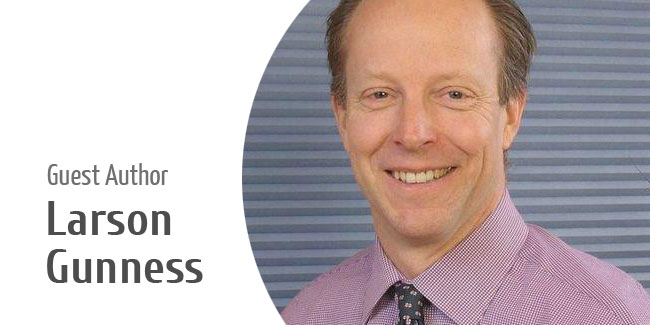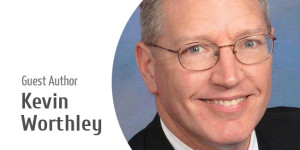The Case For Optimism
When thinking about financial planning, it’s important to consider the long-term. What plans should be put in place in order to prepare for the future? For financial advisor Larson Gunness a central question is this: are we optimistic or fearful of the future? In typical original fashion, his article looks at the urgent global issues of our time and discusses how these relate to our personal financial planning.
Is There Room For Good News?
The Coming Disaster
There are a lot of people these days making the case for extreme pessimism. The past few years have seen a great deal of attention paid to the catastrophes that may befall our society: global warming, economic collapse, terrorism, and Ebola. And with reports about gridlock in Washington and apathy in the general populace, it can sometimes seem that modern society is on a steady decline toward our own ruin. “Things are bad and getting worse” is the message I’m seeing from all quarters. And that’s a pretty grim message. But this has never struck me as completely accurate. I keep seeing evidence of good news. Also, there have been many times in our global history when people have had it much worse than we have it now. So I have begun to collect information about the good news I find. Am I just looking at rare examples of positive news in the midst of our downward spiral? Or am I looking at evidence of a lesser told story? One that might actually be a story about optimism?
We Love Us a Good Catastrophe
We humans have always been very good at envisioning the unravelling of our world as we know it. Religions have been founded to prepare us for the end of days. Literature has long featured this topic. Think of the Bible’s Revelations, A Modest Proposal, The Crucible, The Lord of the Flies, All Quiet on the Western Front, and The Road. In popular media it’s been War of the Worlds, Planet of the Apes, Mad Max, the Andromeda Strain, Silkwood, and more recently it’s Walking Dead, World War Z, Hunger Games, and Maze Runner.
Stories of collapse are not always fiction. Many societies have been caught unaware, thus stumbling in ignorance into their own destruction. The Mayans didn’t expect Spaniards on horseback. The residents of Pompeii didn’t understand geology. All of Europe underestimated Hitler’s Nazis. And there’s the oft-cited comparison between the modern United States and the Roman Empire. I’ve come across scores, even hundreds, of articles, documentaries, blog posts, and talking heads predicting with great certainty our society’s imminent demise. They may be right, and that is a fearful thought. Our society could collapse. Someday.
How Likely is our Demise?
But as I think and worry about the case for pessimism, I keep coming up with questions. Is the cynical view correct? Are we in fact in the last days of the era of American prosperity? Or worse, is the entire society soon going to collapse? Will we find ourselves outside the gates of survivalist compounds, wishing we’d stockpiled as much food, water, and ammo as possible instead of glibly pecking away at our computers and diligently paying off our mortgages?
It’s perfectly understandable why people believe in the case for extreme pessimism. There is a lot of bad news out there. In the discussion over global warming, earlier signs of environmental collapse get very little attention nowadays. Remember acid rain, the collapse of bee colonies, the thinning ozone layer, and the masses of endangered species? Also, the great mountain of economic hardship we all have witnessed since the 2008-2009 Great Recession seems more than ample evidence to support cynicism. The US media has eagerly embraced this sentiment of impending catastrophe, delivering up to us a constant flow of misery and dysfunction.
I was at lunch with some clients the other day, and just behind them on the wall was a TV tuned into one of the mainstream cable news stations. So while we ate and talked, the TV behind them blared a constant gushing of urgent and vital news about Ebola, ISIS, and the plunging stock market… throw in some ads for Walking Dead and it was a veritable orgy of the apocalypse. It seemed absurd, a blatant appeal to the emotions of fear and paranoia. This particular station seems to care very little about providing a balanced review of what’s what… they want to hold our attention long enough that they can deliver us to their advertisers.
The Case for Optimism
So is there a case for optimism? Or would only a fool harbor any sense of hope for the future? I’ve been doing some research. I took some of the big topics: global population, world poverty, environmental degradation, and looked for good news. And I found some. In fact, I found a lot.
Our World in Data (www.ourworldindata.org) was one of my primary sources. Max Roser is an economist working at the University of Oxford. He gathered long-term data on several topics, including population growth, world poverty, violence, public health statistics, and so on. I also read articles about the Endangered Species Act (from the Center for Biological Diversity), bee populations and the ozone layer (from The Good News Network). These studies found evidence that seems to me to be damn good news. As I came across these studies, I felt my biased inner optimist shout There! See? I knew it!
Two conclusions I draw from this research. One, from Max Roser, is that when you look at data trends over many millennia, it appears that we are living in the safest, healthiest, most prosperous period in all of human history. And two, when we humans intervene to impact the problems we’ve caused, sometimes our interventions actually work. Though the monetarist in me hates to say it, it looks like our cumbersome and clumsy regulatory framework can, in fact, achieve success.
Population Growth: In contrast to the famous Malthusian catastrophe model where we will outpace our resources and face subsistence level survival, what the data show is that the rate of population growth is in decline. Since the early 1960s, the rate of population growth has declined to the extent that in the not-too-distant future, I believe that we are likely to see global population stabilize. The determinants of population growth are fertility rates and life expectancy. While life expectancy has been in a long-term increasing trend, fertility rates have declined as poverty declines. The factors that impact life expectancy and fertility are similar: expanded healthcare, education, freedom, safety, and prosperity of people (especially women). They can lead to smaller, more sustainable family sizes and communities.
World Poverty: If you look at global poverty over the course of centuries, you see that the amount of people living in poverty (especially when adjusted for local standards of living) has been in decline. Nations are getting richer and middle classes are growing. Globally, the picture has been getting much better. Most of the improvement is coming in the poorest regions. There’s still a long way to go, but the trend is good1.
Environmental: I heard a GOP leader on the radio say that he’s not a scientist so cannot be expected to understand climate change (of course, he’s also not an economist, or a gynecologist, or a priest..). I don’t want to sound like him. I am worried about global warming. But I am confused about impact. Earlier, I mentioned endangered species, ozone, and bees. I found articles that suggest we should have optimism about each of these. For example the article that looked at the endangered species list challenged the viewpoint that there is no progress there. When the list was put together, each affected species was given a period of time, usually decades, that it would to recover to healthy status. The authors of the article compared the actual recovery rate of species with the projected rate of recovery in their federal recovery plans. Their study looked at species from “all the 50 states, include all major taxonomic groups, and have a diversity of listing lengths.” They found that 90 percent of species are recovering at the rate in their federal recovery plan. This is good news.
Other: Take a long-term view of world health, literacy, violence, and democracy. There are many good news stories. These many trends are interrelated and reinforce each other. Together, they strike me as cause for optimism.
But Wait, You Say, Not So Fast…
Even if what I say above is true, what about global warming, or growing income disparity in the US? What about all of the cities that are in perhaps irreversible decline? How could anyone look at Haiti or the Congo or Eritrea and make any claim about long-term global improvement?
I am not arguing that we can relax our vigilance about global problems. There are tremendous problems in the world that we cannot ignore simply because we were blessed to be born into a stable and prosperous society. I am arguing here that there is a case to be made, a strong case I believe, for optimism. Overall, perhaps the storyline we constantly hear lacks context. Perhaps the system isn’t as near to exhaustion as we’ve been led to believe. And we should keep up our attempts to fix the system because our efforts seem to be working. Slowly, with negative unintended consequences, but working nonetheless.
So how to get a sense of context that is accurate? If the media can’t provide a balanced view, then we need to create one for ourselves. Just how great are these risks we keep hearing about? How should we think about them?
Local Risk – Some of the crises we hear about pose serious threats, but only in a local context. Take the Ebola epidemic. This is an almost unimaginable challenge… in three countries in West Africa (Guinea, Sierra Leone, and Liberia). But how great is the risk to other parts of Africa? How great is the risk in northern Europe? How about the U.S.? Is this really a risk to us? To put it in perspective, as of this writing, more Americans have married Larry King than have contracted Ebola. Another example might be when a powerful storm devastates one region, the impact to someone in another hemisphere might be negligible. Despite media coverage that makes us feel like all crises are closer to home, when thinking about a particular risk, it’s critical to consider whether the risk is far-reaching or actually quite localized.
Systemic Risk – Not all risks are local. Some challenges are bigger. Some challenges could impact the whole world. The most prominent example of this is, perhaps, global warming. The reports seem dire: we’re nearing a tipping point, the sea levels are rising, most scientists agree this is a manmade problem, and so on. Dissent with this case-making is widely shouted down as counterproductive to the cause. When faced with a system-wide risk, weighing the costs of action against the costs of inaction becomes the main task. How bad could it really get? How much would it really cost to cause positive change? How much impact can we actually have? There is a lot of hyperbole out there. In order to cause changes in behavior on a global scale, urgency is necessary. And global destruction sure focuses us on the problem. With global warming, it seems to me that we have to act because the potential negative impacts are so great as to be unacceptable. But no one is sure how the negative (and, yes, positive) impacts of global warming will play out. So with global systemic risk, it seems that the analysis needs to clarify the probability of negative outcomes and the costs/effectiveness of solutions. Given evidence of the past, I think our track record for resolving system-wide issues is actually positive.
But we might need to have our backs up against the wall before we actually collectively pay enough attention to make the needed changes.
The Economic Ecosystem
The forest pond has become my favorite analogy for the economy. Our economy is an ecosystem, like a forest pool. I got so excited about this analogy that I thought I had come up with a whole new way of thinking about economics: the economy as ecosystem. Wow. A whole new school of economic thought, one that unified and explained the intricacies of cause and effect, all created by me, now that’s really something… until I discovered that there was already an MIT-led school of economics called bionomics which formally presents this viewpoint. Oh well, it’s still a great analogy.
Think of our little pond in the universal forest. It’s an ecosystem (economy) full of species (businesses, sectors, entities) that coexist and compete. The state of health in our pond is derived from many interrelated factors. Some factors cause species within the pond to thrive, some factors cause damage to species. When some species thrive, others might thrive too, or they might decline. It is a system constantly in search of new equilibrium. And the thing about equilibrium is that it is never quite reached, at least not for long.
It is possible for the entire system to collapse. It is also possible for the system to self-regulate and to evolve and seek periods of new stasis, different from the previous norm. We canintervene in that system and try to encourage or discourage various things from taking place. We could aid a certain species that we think is important, or we could try to slow the growth of something that we believe is harmful. But our tools for intervention are crude, and while they may do what we intended to do, they may also have unintended consequences. It can happen that the cost of the unintended consequence outweighs the benefit of our intended action. I imagine archetypal beings looking over this pool, each with its own viewpoint on how to help it thrive. Think of the hippy environmentalist, certain that her loving and careful policies will create the perfect harmony. But beside her crows her hunter/fisherman adversary who wants her to just stay clear of the fray so that she doesn’t mess it all up (when in fact what he really wants is for the hippy to go gaze at lily pads while he strings up his fishing rod and tries to land a big one).
I’ll explore this forest pond analogy in future writing. For now, consider that maybe the long-term health our economy is evolving, and sustainable. That doesn’t mean that all sectors, jobs, even cities will survive. But taken as a whole, I think the evidence is actually cause for optimism.
What does this Mean for Investors?
In making this case for optimism, I’m not also making the case that investors should ignore risk. The markets may continue to have booms and busts. Bubbles may inflate and burst. These cycles can be painful and can last for many years. To paraphrase Maynard Keynes, the markets can remain irrational longer than you can remain solvent. So it is important to maintain an asset allocation strategy that is in sync with your risk profile, your time horizon, and so on. My case for optimism is about the long-term. The point is that long-term investors can, I believe, expect stocks to rise. While stock investing involves risk, including loss of capital, the trends I discuss in this paper support the notion that investing in stocks is a prudent long-term strategy.
Larson Gunness is the owner and managing director of Gunness Financial Services, a financial planning and investment management firm based in Barrington, RI. A musician and writer, he is also the author Peace, Love and Financial Planning: An Illustrated Guide to Money. Larson can be reached at www.gunnessfinancial.com or e-mail him at: larson@gunnessfinancial.com.
Any views, opinions, and statements are those of Larson Gunness exclusively and may not represent the views, opinions, and/or statement of Aaronson Lavoie Streitfeld Diaz & Co, PC or its officers or owners. Nor has Aaronson Lavoie Streitfeld Diaz & Co reviewed or authorized the information Larson Gunness has presented and it expresses no warranty on them.
The opinions voiced in this material are for general information only and are not intended to provide specific advice or recommendations for any individual. To determine which investment(s) may be appropriate for you, consult your financial advisor prior to investing. All performance referenced is historical and is no guarantee of future results.
The economic forecasts set forth in the presentation may not develop as predicted and there can be no guarantee that strategies promoted will be successful.





